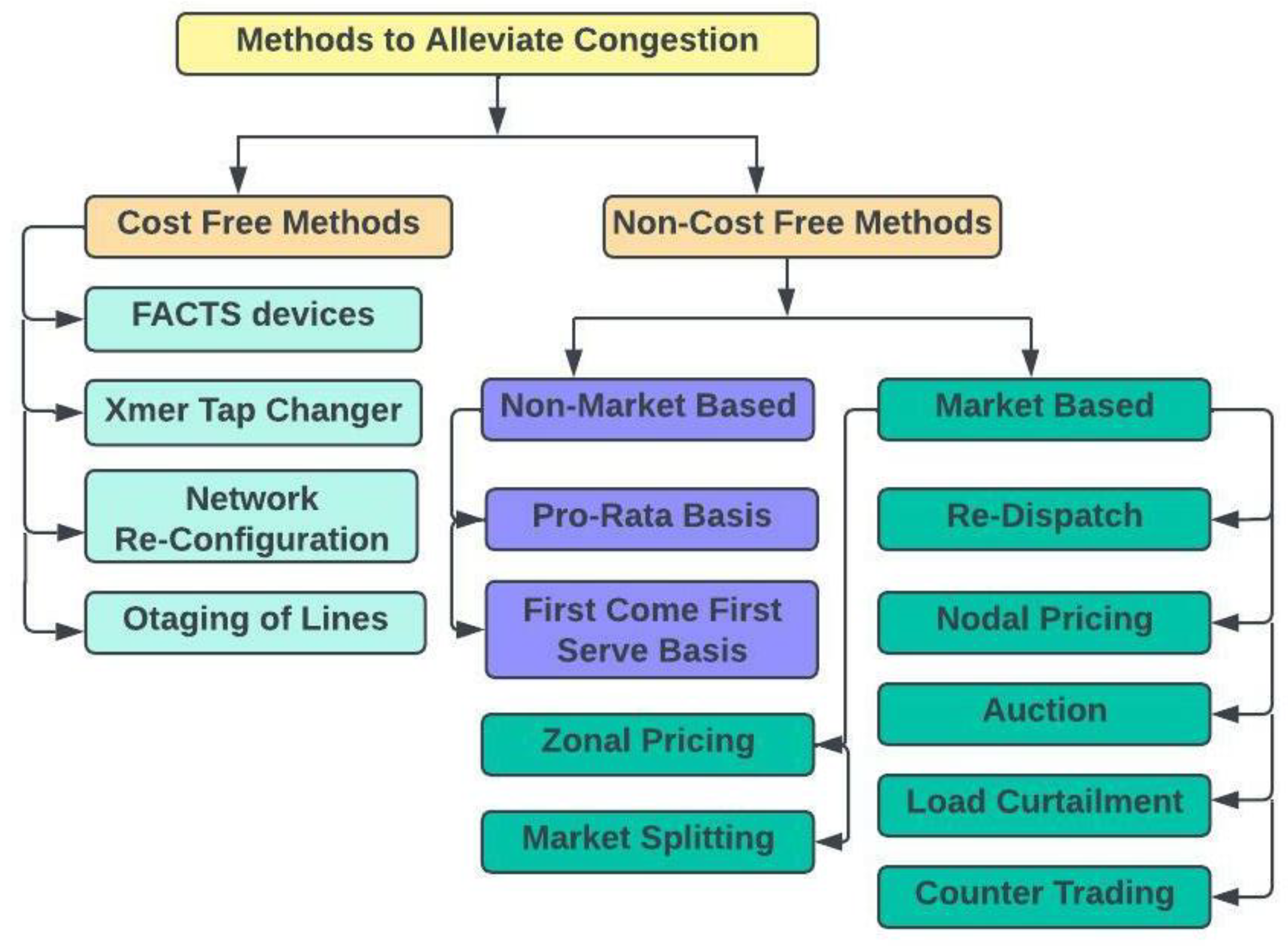You're using an outdated browser. Please upgrade to a modern browser for the best experience.
Please note this is a comparison between Version 2 by Camila Xu and Version 1 by Anurag Gautam.
Economic and geographical constraints led to reforms and deregulations in the power system to utilize resources optimally within the existing framework. The major hindrance in the efficient operation of the deregulated power system (DPS) is congestion, which is the result of the participation of private players under deregulation policies.
- deregulated power system
- congestion
- power flow
1. Introduction
With technological and industrial developments, power demand has escalated exponentially. It was economically unfeasible to lay down new transmission lines. Local energy resources were not exploited efficiently due to economical and geographical reasons. Therefore, the focus was on the implementation of policies that can allow the increase in generation and fulfill the recursively enhanced demands. Initially, the power system was vertically integrated, where the rights for generation, transmission, and distribution were exclusive to the government. There was a monopoly in the power system and, thus, a dire need to restructure the power system. The power system was then restructured to obtain the DPS, as shown in Figure 1. The entire power system is segregated into three main parts: the generation companies (GENCOS), the transmission companies (TRANSCOS), and the distribution companies (DISCOS). GENCOS are the generation companies which are the owners of generator plants. Their main role is to operate and maintain the generation units. These have unbiased access to the transmission network. The GENCOS may either be a government or a private unit. TRANSCOS are the transmission owner companies which own the transmission network. These companies provide open access to the generators without any bias to a particular generating unit. Generally, this utility is in the public sector as this is the costliest part of the power system. DISCOS are the distribution companies. These companies may either be in private or public sectors. In the deregulated environment, DISCOS are generally restricted to the distribution of energy and offer services for electricity distribution. Apart from these three entities, there is an independent system operator (ISO), which is the ultimate authority in controlling transmission. There are three basic functions of an ISO: to maintain the security of the network, to ensure reliable service quality, and to maintain power system efficiency. There are retailers in the DPS which are segregated from the DISCOS in the deregulated power system as they have the role of offering electricity sales to the end users. Power exchangers (PX) offer a medium to tie electricity supply and demand for existing and forthcoming power markets.
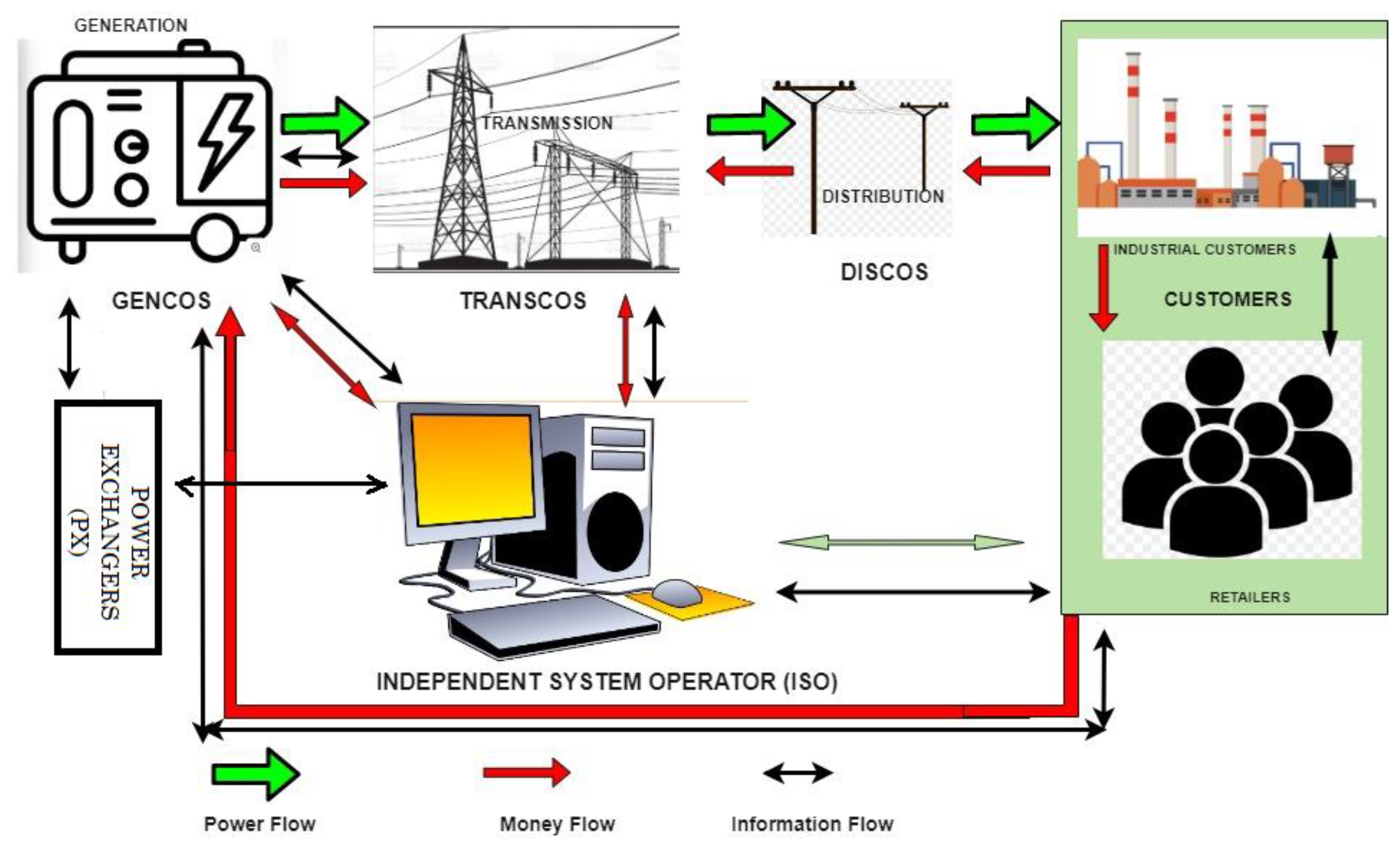
Figure 1.
Deregulated power system.
However, there are many hindrances to implementing the deregulation policies. All energy policies include strategies to invite private market players, auction regulations, alleviation of market powers of accomplices, control on energy prices, the autonomy of transmission, and stable and efficient working of the electricity market [1]. With the increased participation of private market players, a new challenge, congestion, is faced by the system operators. In the deregulated power system, numerous private generators supply power to the consumers through power agreements. These generators use common transmission lines without any bias. Sometimes due to faults, extreme weather conditions, undeclared bilateral transactions, etc., one or more transmission lines becomes overloaded and is not able to transfer the contracted power to the loads. This condition is called congestion. Congestion not only affects the system physically, but it also adversely affects the system’s economy. The main reason for this menace is the overloading of existing transmission lines, mismatched generation and transmission, unforeseen increases in demand, outage of one or more generators, and failure of system equipment [2].
2. Methods to Alleviate Congestion
Congestion also occurred before the power system was deregulated. The main reason behind the congestion was the weakening or deterioration of the transmission lines due to the scheduled outages in the system. Then, the congestion mitigation was achieved by the rescheduling of power, changes in transformer taps, and phase angle regulation. Congestion is the undesired condition in the deregulated power system when the lines are incapable of transmitting the scheduled power to the loads. This condition arises because of the escalation in the number of power transactions due to the enhanced number of market participants. Private players in the generation, transmission, or distribution affect congestion differently. The effect differs in accordance with the availability of power in the neighborhood and as per the severity of demand in the system. The location of private generators is also one of the major factors affecting congestion. The power transfer in long transmission lines is limited by the magnitude of the voltages at the two ends, voltage angles, the reactance between the two ends, and the corresponding reactance angle. Apart from these features, the climatic condition, geographical features, the age of the transmission lines, and the increase in load demand are some of the physical features restricting the amount of power flow in the transmission lines. To decide the appropriate method of CM, it is essential to know the major impacts of electrical congestion The effects are listed as follows:- (a)
-
System disturbances causing added outages in an interrelated system;
- (b)
-
Reduced market efficiency;
- (c)
-
Hike in energy prices;
- (d)
-
With an increase in electricity charges, the loads are enforced to decrease the power consumption;
- (e)
-
Adverse security concerns;
- (f)
-
Operation of the system with stability margins;
- (g)
-
Frequent initiation of cascade tripping.
2.1. Cost-Free Methods
These methods consider the operational costs constant. These are also called technical methods. Here, the economy of the system is not affected by the application of these methods to alleviate congestion. Technical methods are further classified into the following.2.1.1. Application of a Flexible AC Transmission System (FACTS)
The implementation of a FACTS device is the most effective way to mitigate congestion in the DPS due to their effectiveness in manipulating EPS parameters rapidly. FACTS devices are very efficient in maintaining the voltage profile at the buses. These devices are very useful in reducing power loss in the transmission lines, thus reducing the overloading of the lines. Available transfer capability (ATC) is increased efficiently by the implementation of these devices. FACTS can be employed in series, shunt, and a combination of the two. A number of methods to implement FACTS devices are investigated and proposed in the literature. Different types of FACTS devices depending on their location in the DPS are presented in Table 1, in which P represents active power and Q represents the reactive power of the system.In the current deregulated power system, due to the advancement of power electronic technology, the employment of FACTS devices has escalated manifold. The use of a gate turn-off (GTO) thyristor for the practical implementation of efficient power transactions is reported in [9][7]. To reap the maximum outcome of the FACTS device, the optimal location of the FACTS is proposed in the transmission network [10,11,12][8][9][10]. The effectiveness of FACTS implementation for congestion management (CM) depends on the efficiency of the FACTS to reduce CM cost and is reported in [13][11]. Locational marginal prices (LMPs) are used as a base to locate the most congested lines in the system for employing series FACTS devices. The effect of the device on pool market pricing is established in [14][12]. The sensitivity factor approach to locating the UPFC for relieving overburdened transmission lines is reported. The efficiency of the UPFC to mitigate congestion is enhanced by suitably locating the device using sensitivity factors [15][13]. Multiple FACTS devices are reported in the literature to alleviate congestion more effectively. Series FACTS devices, such as TCPAR, IPFC, and TCSC, are located in the transmission network and effectively implement the devices by using sensitivity factors such as the power flow performance index (PI), the line utilization factor (LUF), and the disparity line utilization factor (DLUF), which are used in [16,17][14][15]. SSSC, UPFC, and STATCOM are very efficient devices used in the power system to mitigate congestion. Power sensitivity factors are reported in [18][16] together with the penetration of windfarm to determine the effect of FACTS devices on mitigating congestion. The manipulated voltage profile, enhanced power loss, reduced security margin, and reduction in the ATC of the system are the most severe effects of congestion. Shunt FACTS devices, such as SVC, and the series FACTS device TCSC are implemented in [19][17] to enhance the total transfer capacity (TTC) and the security margin of the congested power system. IPFC is implemented in [20,21][18][19] to optimize the multiobjective function to reduce system power losses and to enhance the static security margin for alleviating congestion in the overburdened lines. The papers employed artificial intelligent controllers (AIC) and gravitational search algorithms (GSA). The example to illustrate CM by the implementation of FACTS devices is taken from [21][19] and shown in Figure 3.FACTS Devices Nomenclature Position in the EPS Controlled Parameter SVC Static VAR compensator Shunt Q TCR Thyristor controlled reactor Q TSC Thyristor switched capacitor Q TSR Thyristor switched reactance Q STATCOM Static synchronous compensator Q TCSC Thyristor controlled series capacitor Series P IPC Interphase power controller P TSSC Thyristor switched series capacitor P TCSR Thyristor controlled series reactor P TSSR Thyristor switched series reactor P TCVR Thyristor controlled voltage regulator P SSSC Static synchronous series compensator P IPFC Interline power flow controller Series–Series P and Q UPFC Unified power flow controller Series–Shunt P and Q Here, the from the figure it can be observed that after overloading the load buses of the IEEE 30 bus system, the power loss of the system is enhanced, creating congestion. With the help of IPFC, the real and reactive power losses are significantly reduced, alleviating congestion. Figure 3.Illustration of CM by FACTS.
Figure 3.Illustration of CM by FACTS.2.1.2. Phase Shifting Transformers
The phase shifting transformer (PST) for CM in the DPS is discussed in the literature. The PST reallocates the active power flows in the transmission lines to relieve the overloaded lines to mitigate congestion. The benefit of implementing the PST is that it sidesteps the excess power generation and re-dispatch, which involves the economics of the system. A 24 h day ahead schedule is proposed for the PST in [22,23][20][21] to reduce the number of interventions of the operator. The real power is diverted from congested to the underloaded lines to reduce congestion in the system using PST and employing the PSO for ideal PST phase settings [24][22]. To apprehend this change, load tap changers are deployed to induce a flexible phase shift to manipulate the subsequent phase angle. Figure 4 illustrates the result of the application of the PST in reducing the unscheduled power flow (UF) causing congestion in the system. In Area 1, the UF is reduced from 110 MW to 51.1 MW; in Area 2, the UF falls from 12.9 MW to 8.1 MW, with a 36.8% reduction; and in Area 3, the UF is again reduced from 12.9 MW to 8.1MW. Figure 4.CM by phase shifting transformers.
Figure 4.CM by phase shifting transformers.2.1.3. Network Reconfiguration
Network reconfiguration means altering the line topology by opening and closing the sectionalized and tie switches between the interconnected lines in distribution systems. Before reconfiguration, it is essential to locate the most congested area to which reconfiguration is to be applied. In [25[23][24],26], a genetic algorithm (GA)-based reconfiguration algorithm is proposed to find the most congested area to reduce the system losses and alleviate the over-voltages for mitigating congestion. A method to optimally establish the system configuration for mitigating congestion following system security limits under the contingency condition is proposed in [27][25]. Dynamic tariff (DT) and re-profiling products are integrated here to mitigate congestion in a system with several distributed generation resources. Figure 5 presents the CM by network reconfiguration [26][24].From Figure 5, it can be observed that for the reconfigured network with some switches open, power loss in the system is reduced from 10.108 MW to 9.9875 MW, hence reducing congestion in the system.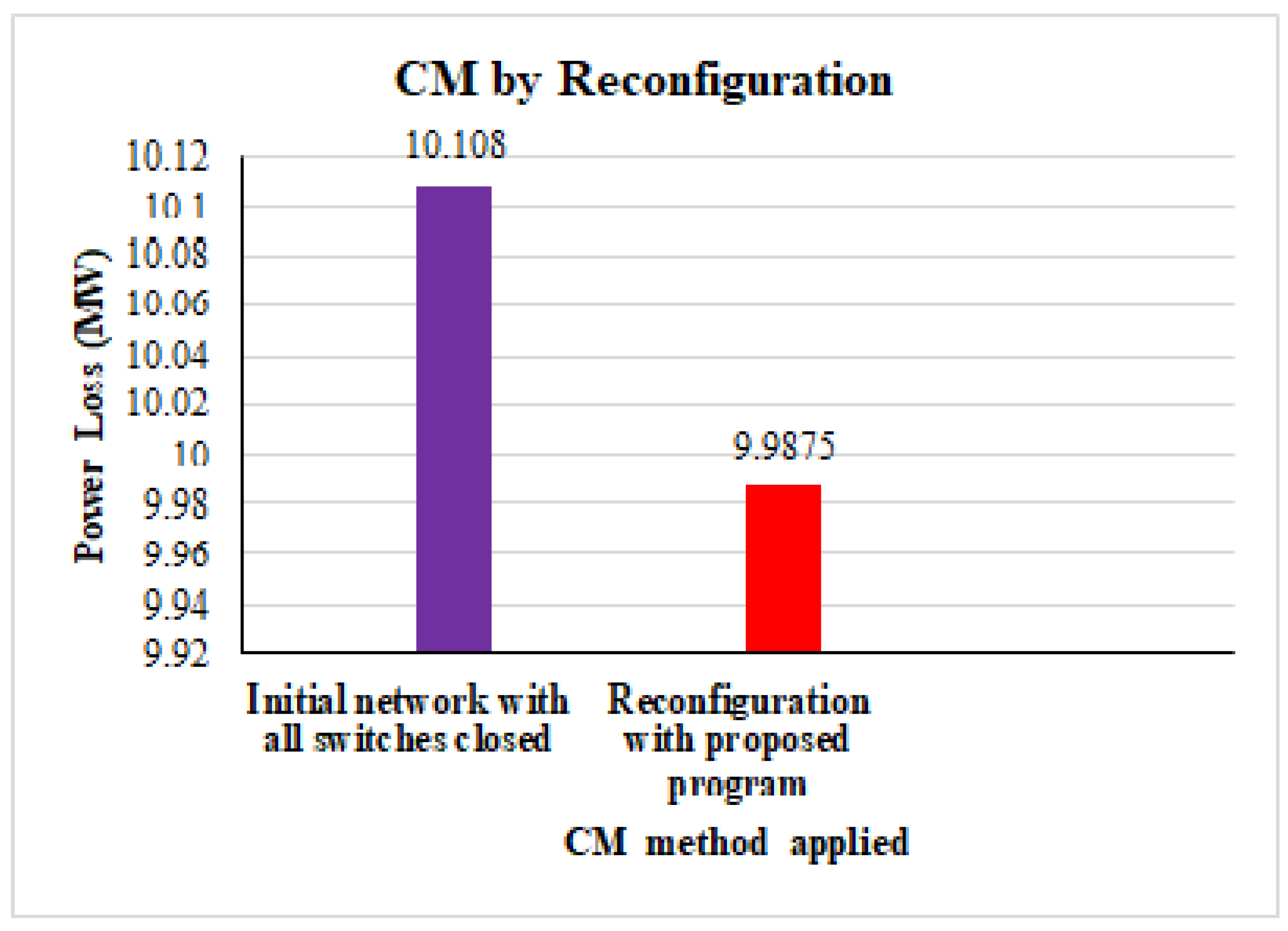 Figure 5.Illustration of CM by network reconfiguration.
Figure 5.Illustration of CM by network reconfiguration.2.1.4. Available Transfer Capacity (ATC) Enhancement-Based CM
ATC is the capacity of transmission lines to supply power over and above the scheduled and agreed power demand to be utilized for commercial purposes. ATC can be mathematically represented asTTC is defined as the total transfer capacity, TRM is defined as the transmission reliability margin, ETC is defined as the existing transmission commitment, and CBM is the capacity benefit margin. The value of TRM is taken as 10% of the TTC while CBM is related to the generators’ profit and is usually taken as zero. ETC is different for different systems and is taken accordingly. CM can be effectively achieved by enhancing the ATC of the system. The transmission congestion distribution factor (TCDF) is employed to locate the wind generators (WGs) for enhancing the ATC of the system [28][26]. Various FACTS devices, such as UPFC, STATCOM, and SSSC, are optimized in [29][27] for their parameters to enhance the ATC by employing PSO. TCSC is employed in a congested system with ACPTDF as a location sensitivity factor, a parameter being optimized by metaheuristic evolutionary particle swarm optimization (MEEPSO) for ATC enhancement to mitigate congestion [30][28]. The CM by ATC enhancement for [29][27] is illustrated in Figure 6.ATC = TTC − TRM − ETC − CBM.Figure 6 shows the increment in the ATC of the system under the contingency condition by applying STATCOM and SSSC as the FACTS devices. With the enhancement of the ATC, more power can be transmitted without reaching the thermal and voltage limits of the line.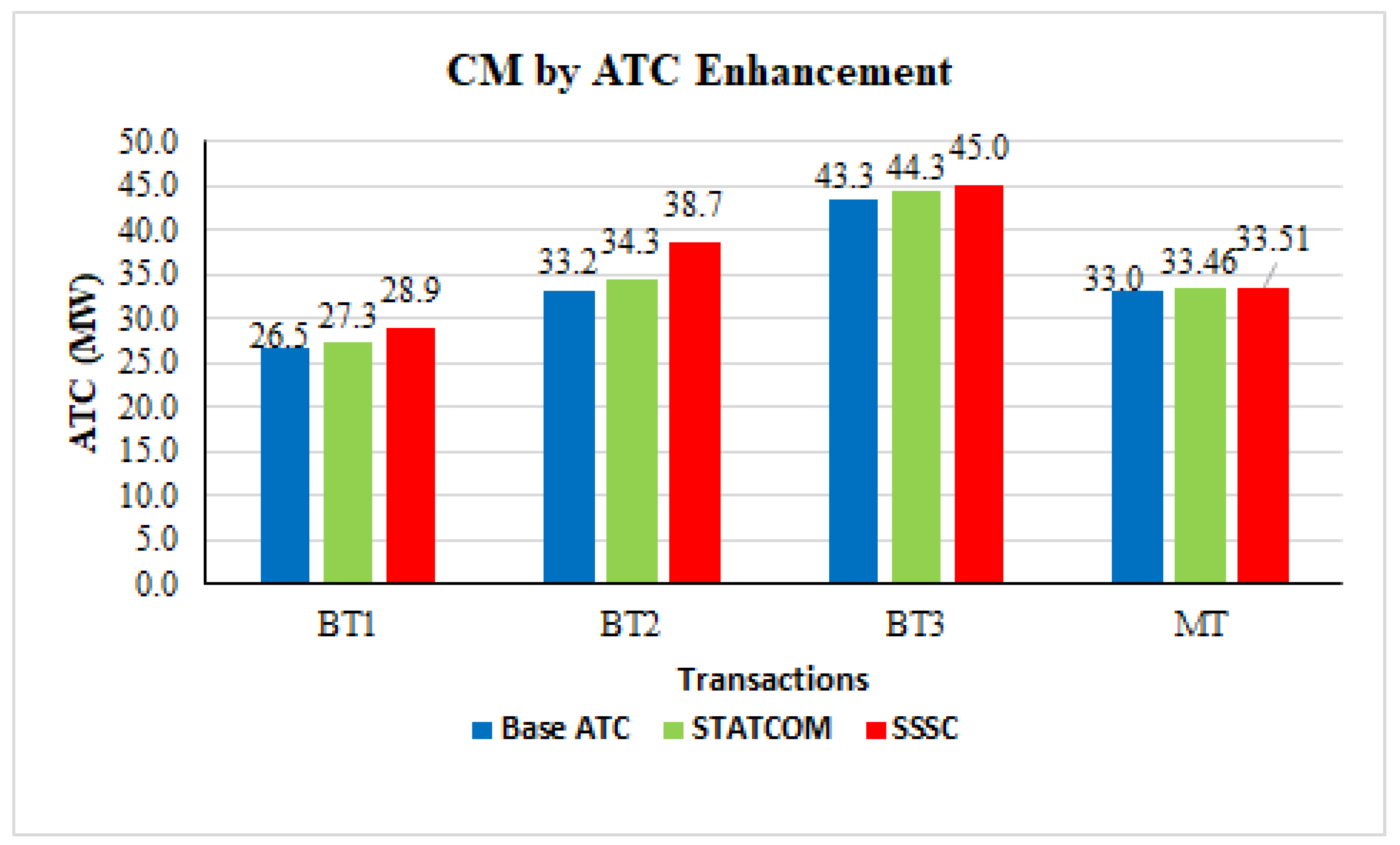 Figure 6.Illustration of CM by ATC enhancement.
Figure 6.Illustration of CM by ATC enhancement.2.2. Non-Cost-Free Methods
Non-cost-free methods are those that affect the economy of the DPS. In these methods, the economic aspects of the system are considered, leaving behind the technical aspects to mitigate congestion. The operational cost of the DPS is kept at the highest priority while applying these methods.2.2.1. Congestion Alleviation by Generator Rescheduling and Load Curtailment
Generator rescheduling (GR) with or without load curtailment (LC) is an extensively used method to relieve congested lines. In this method, the generator’s active power output is rescheduled by the bid submitted by the respective generators. In the deregulated market, congestion occurs due to contractual settlements between the sender and buyers. These settlements may be declared or undeclared. When the generators are rescheduled, there is an enhancement in the cost of generation. Thus, the cost of rescheduling is kept as low as possible by the monetary agreements in the pool electricity market. When the congestion remains even after the rescheduling process is complete, load curtailment is performed where the demand of the system is reduced to mitigate congestion. For determining the participating generators in the rescheduling process, sensitivity factors such as transmission congestion distribution factors (TCDFs) are proposed in [31][29] and the cost of rescheduling is reduced by applying PSO. A generator sensitivity factor (GSF) is applied to decide the participating generator. The ant lion optimization algorithm (ALO) and the flower pollination algorithm (FPA) are proposed to reduce congestion cost [32,33][30][31]. In the day-to-day electricity market, CM is achieved by GR which, in turn, is based on the proposed relative electrical distance (RED) method in [34][32]. The cuckoo search algorithm (CSA) is applied to reduce the congestion cost in a system with renewable energy resources [35][33]. GR is performed by applying voltage-dependent load modeling and an integrated pumped storage hydro unit (PSHU) is proposed in [36,37][34][35]. The site for the PSHU is decided by the bus sensitivity factor, while the generator participating in rescheduling is decided by the GSF. A moth–flame optimization (MFO) is proposed to lessen the cost of congestion while reducing the amount of active power rescheduled [38][36]. To decide the range of real and reactive power rescheduled for minimum congestion cost, power sensitivity factors are proposed. Further, the black hole algorithm (BHA) is suggested to re-dispatch the generators in [39][37]. CM from [32][30] is demonstrated in Figure 7.Figure 7 illustrates the redistribution of line flows in the previously congested lines 2, 4, and 7. Initially, the power flow violates the limits creating congestion. With generator rescheduling, the overloaded lines 2, 4, and 7 are relieved to carry 128.8 MW, 118.8 MW, and 76.3 MW only.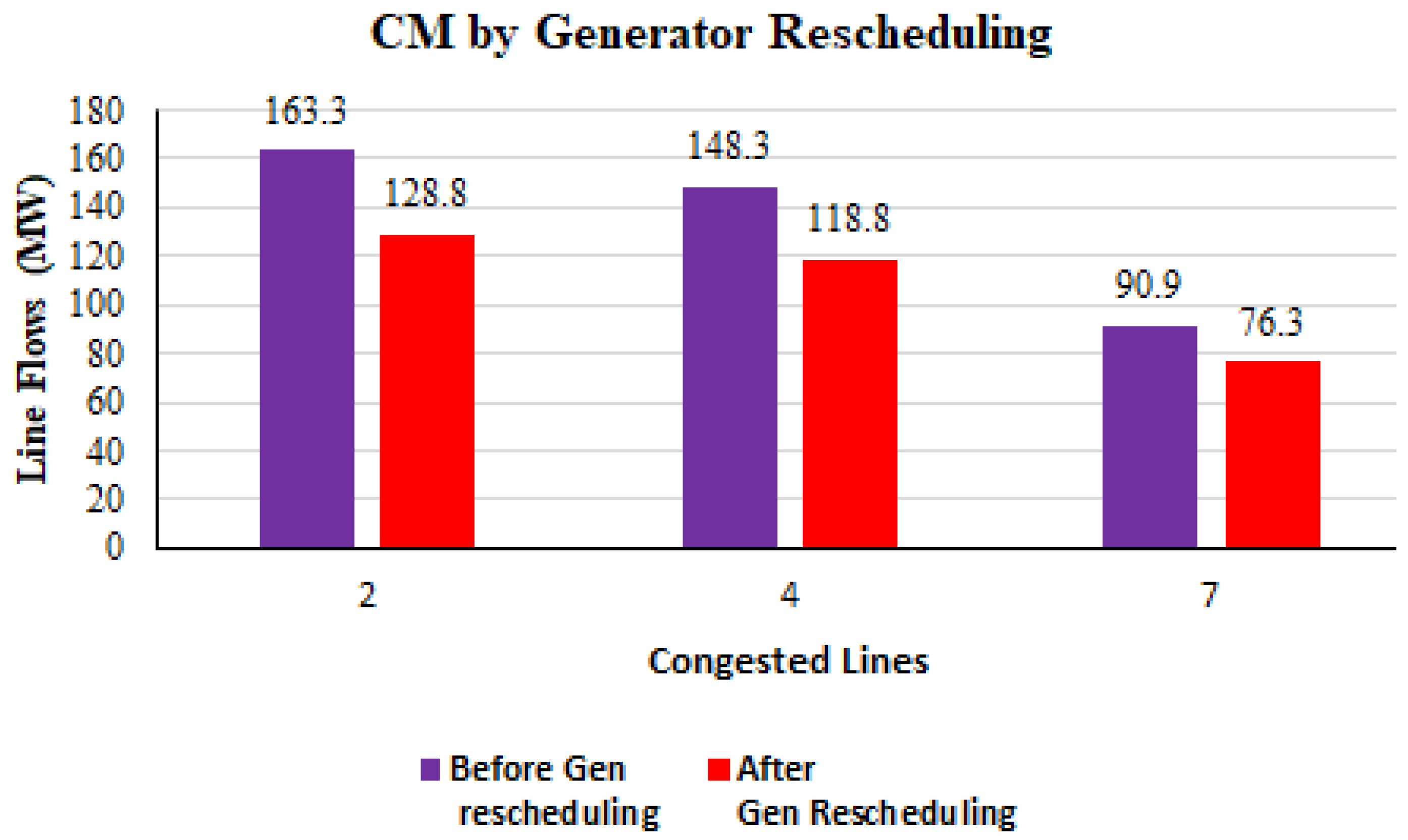 Figure 7.CM by generator rescheduling.
Figure 7.CM by generator rescheduling.2.2.2. First-Come, First-Served (FCFS) and Pro-Rata Method
The capability of the network is assigned by the order in which the ISO receives demands from the buyers for contractual transmission services. The first request received is assigned as the first network capacity. Then, until the network capacity is exhausted, the other requests in the sequence are allowed to receive. The advantage of this first-come, first-served strategy is that it helps private market players generate long-term forecasts. This makes the system more secure as the system operator knows the transmission requirements well in advance. This process seems to be very efficient for bilateral trading but is not very suitable for deciding the priority in the pool-based energy market or day-ahead electricity market as mentioned in [40][38]. To manage the disadvantage of the first-come, first-served method, another method is the pro-rata basis of network allocation. In this method, the network allocation is not based on the sequence of requests made, but rather on the proportion of their proportional requirement [41][39].2.2.3. Auction-Based Methods
In the DPS, unbiased transmission access is ensured by the transmission system operator (TSO). The transmission capacity allocation is performed with the constraints. The auction of transmission capacity is undertaken by the TSO based on the bids submitted by respective market players in the pool-based electricity market. The basis of the allocation of transmission rights carried out by the TSO is to provide a congestion-free environment in the power system, as proposed in [42,43][40][41]. Splitting of the congested market is proposed with real-time market clearing hardware which accepts the auction data and implements them to clear the congested market in the power system [44][42]. A detailed review of congestion management employing generator rescheduling, FACTS implementation, and auction-based CM is presented in [45][43]. Interruptible load-based and LMP-based auction methods to mitigate congestion are proposed in [46,47][44][45]. This method can be illustrated from [46][44] below. In Figure 8, the effect of auction-based CM on usual business hours is shown. NILS means the number of load buses with load interruption and PILS is the power interruption invoked. Here, the ISO prefers to reduce the net load interruption constraint; it must reduce the maximum number of interruptible buses when the current market price is lower than before. This way, auction-based CM alleviates the congestion in terms of market price.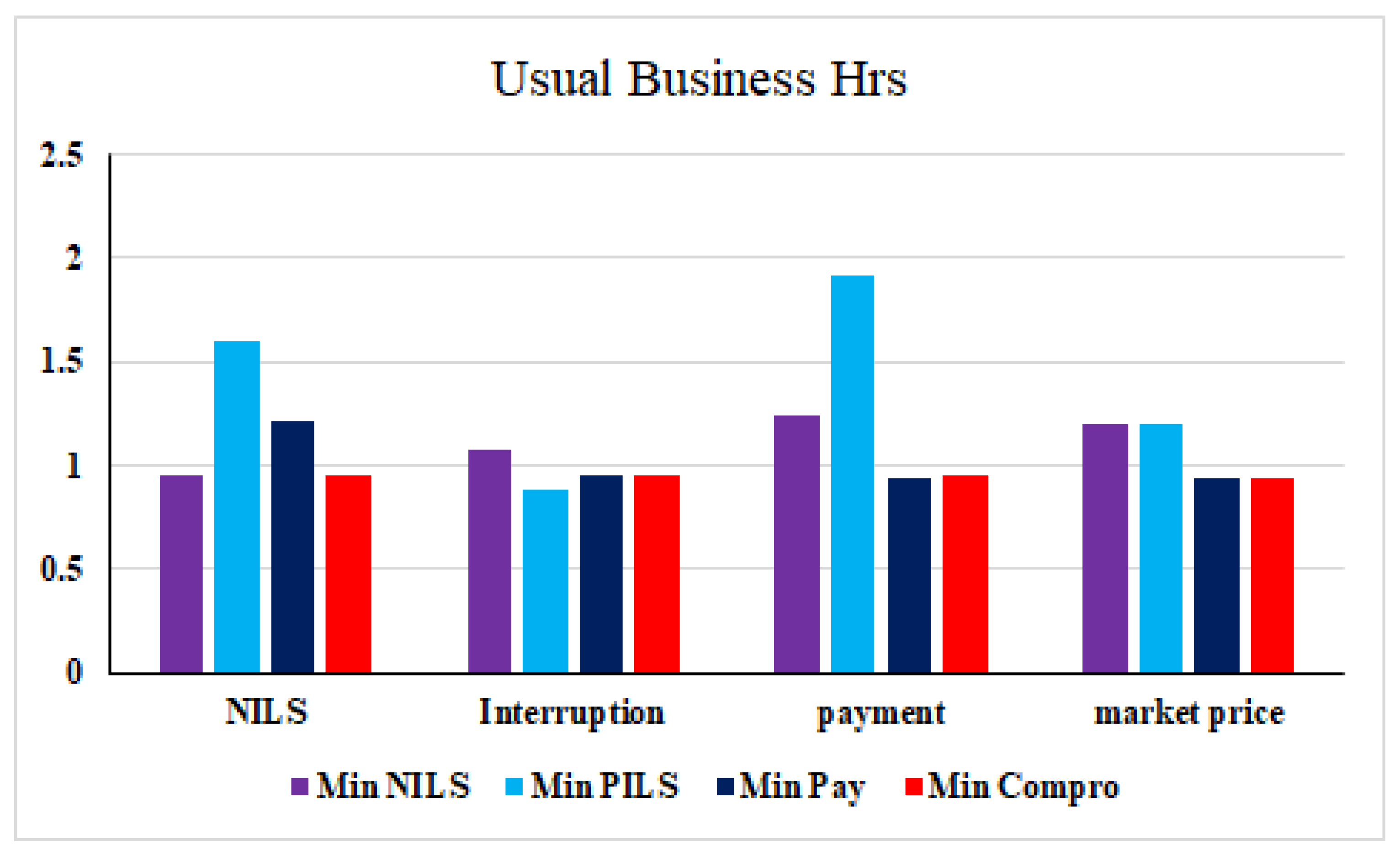 Figure 8.Illustration of CM by the auction-based method.
Figure 8.Illustration of CM by the auction-based method.2.2.4. Load Curtailment-Based Methods
The load curtailment method is a way to mitigate congestion by shutting down some of the loads in the congested transmission system. This strategy of CM includes market splitting where, at first, the dispatch is scheduled without considering constraints. If the congestion persists, then the market is split and cleared individually. Here, the ISO acquires power from a region with a low price and then supplies it to the region with a higher price. This CM method is applied in the Norwegian market. The load curtailment method copes with the existing loads in a way that efficiently mitigates congestion in the network [48][46]. The load curtailment is kept as small as possible so that the price drop in the congested regions is as low as possible. Willingness to pay for avoiding curtailment is used as a factor to decide the amount of load curtailment, as presented in [49,50,51][47][48][49]. To illustrate the CM by load curtailment, an example from [52][50] is shown in Figure 9. Due to unscheduled bilateral and multilateral transactions in the pool-based electricity market, congestion is created. The active power limits for bilateral and multilateral markets are 150 MW and 90 MW, respectively. After congestion, the line flows in congested lines are 151.285 MW and 93.096 MW for bilateral and multilateral transactions, respectively. The loads to be curtailed are selected by optimization techniques. After load curtailment, the congested power for bilateral transactions is reduced to 0.997 MW, while that for multilateral transactions reduces to 2.168 MW only.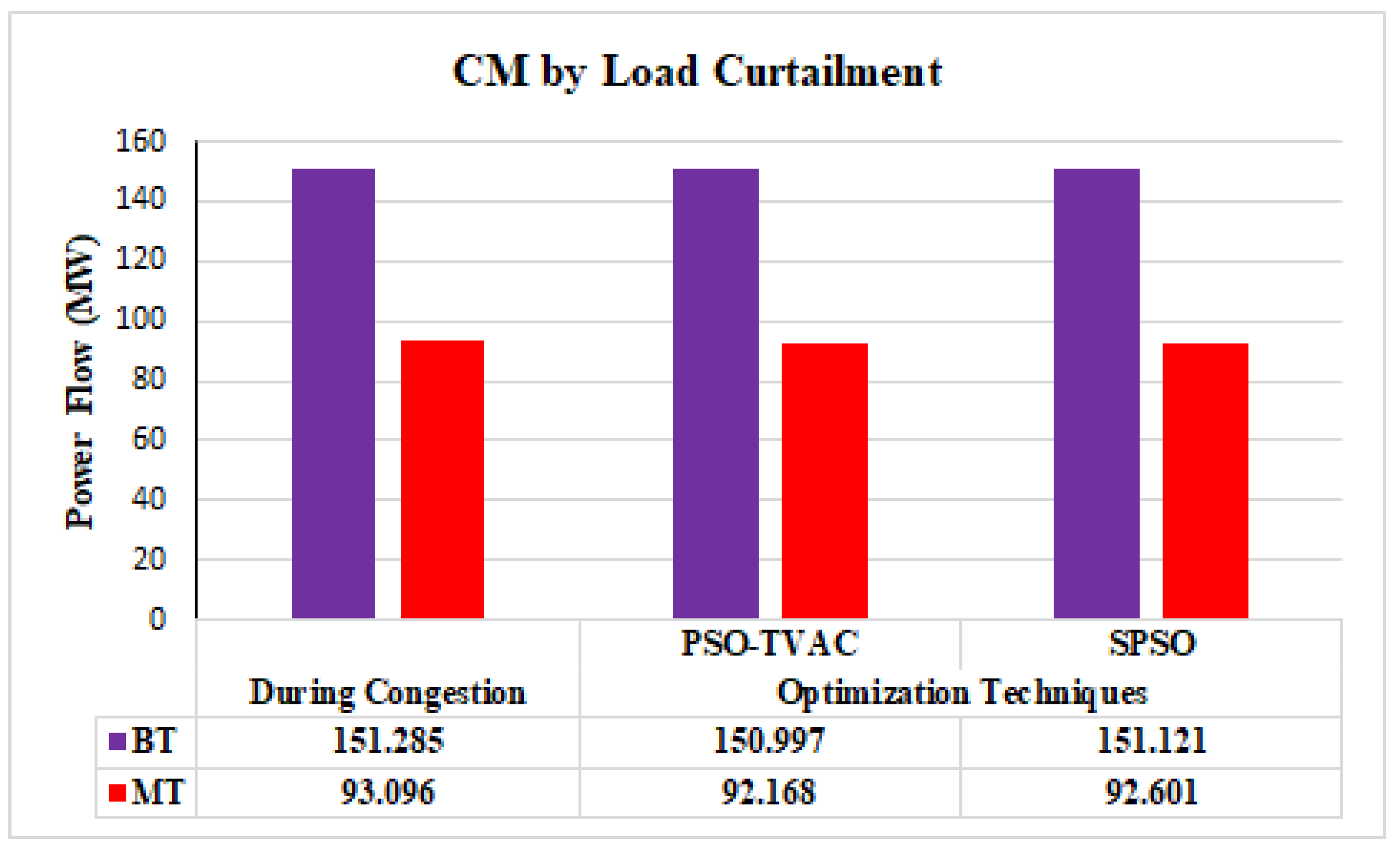 Figure 9.Illustration of CM by load curtailment.
Figure 9.Illustration of CM by load curtailment.2.2.5. Nodal Pricing (NP) Methods
NP method is a customary method for alleviating congestion in the overloaded power system due to its unique property of efficiently allocating transmission capacity without congesting the network. The nodal price in the optimization problem varies by the location of the node in the congested system. The cost of supplying the successive increment of load, including cost caused by loss due to the increment of load and transmission congestion cost at a bus, is called the locational marginal price (LMP) [53][51]. The non-linear power system equations are solved by employing GA together with the generator scaling factor to find the LMP for mitigating congestion [54][52]. Capacity procurement to balance the power market and to locate control reserves is proposed by using the LMP [55][53]. The semidefinite programming (SDP) relaxation method is proposed to derive LMPs. The signal for the future market is analyzed to reduce losses and alleviate congestion using the LMP [56][54]. A transactive energy (TE) framework using the distribution locational marginal price (DLMP) for distribution systems is proposed for smart market players playing consumers and suppliers [57][55]. A breakdown of NP for generation, transmission, and voltage constraints in the New England power system for CM is proposed in [58][56]. Utilization of congestion cost and optimal node price for CM in the transmission lines with the LMP in the PJM market is proposed in [59][57]. This method is illustrated in Figure 10, as proposed in [60][58]. There is a redispatch of generators with the change in LMPs to alleviate congestion with a minimum cost of congestion. In this case, the congestion cost is reduced from 1000 USD to 600 USD with the new redispatch. Figure 10.Illustration of CM by the nodal pricing method.
Figure 10.Illustration of CM by the nodal pricing method.2.2.6. Distributed Generation (DG) Method for CM
Deregulation in the electricity market has brought congestion in the power system due to the overutilization of the existing transmission framework. Due to congestion, the voltage profile becomes degenerated. The employment of DG plays a crucial role in maintaining the voltage profile within the pre-defined limits for system stability. Distributed generators (DGs) help to reduce congestion by reducing the power flows through congested lines. With the advancement in technology, DG exploits the regional renewable resources in economical ways, hence obtaining generous profits that repay their invested capital and inspire an increased deployment of DG. To achieve maximum benefit and CM, DG must be placed at the optimal location. A real coded GA and NSGA II method is proposed in [61][59] for the optimal location and sizing of the DG. The DG play a crucial role in a very congested system with very high LMPs. The placement of DGs at such locations reduces the energy prizes as proposed in [62][60]. An LMP-based DG location is presented to enhance social welfare and the voltage profile [63][61]. Renewable energy-based DG placement is employed in the power system to mitigate congestion. A salp swarm algorithm (SSA) based on Artificial Intelligence (AI) is proposed in [64][62] to locate the wind power plant (WPP) as DG in the power system for CM. Sensitivity factors are very important in obtaining the location of the DG. Some of the sensitivity indices such as the voltage profile index [65[63][64],66], loss reduction index [67][65], environmental impact reduction index [68][66] and, DG index [69][67] are proposed in the literature. Increasing the system security by optimal DG placement using the difference between maximum LMP and LMP is proposed in [70][68]. A cost/worth analysis-based and flow gate marginal price-based method is proposed in [71,72][69][70] to place DG at the optimum location for CM. Energy storage systems and renewable energy resources (RES) are reported to charge and discharge to overcome the uncertainty of RES [73][71]. Figure 11 illustrates a case of congestion management by DG placement proposed in [74][72]. It can be observed that the total percentage loading on the congested lines (33–34, 20–33, 16–17, and 14–34) is reduced significantly to alleviate congestion in the system.A brief comparison of different approaches for CM is shown in Table 2. Figure 11.CM illustration by DG placement.Table 2. A comparison between different CM approaches..
Figure 11.CM illustration by DG placement.Table 2. A comparison between different CM approaches..Approaches of CM Type of CM Advantages Disadvantages 1 FACTS-based CM Cost-free Increases the power transfer capacity, stability, and controllability of the networks by series or shunt compensation. Very costly, needs very precise adjustment of FACTS parameters, a very accurate location is to be determined. 2 Phase-shifting transformers Cost-free Increases the overall capacity of grids, reliable and economic power flow management. Cannot increase the individual capacity of lines, works effectively under low congestion values. 3 Network reconfiguration Cost-free Reduces line losses, improves voltage profile, reduces peak demand reduction in overloading of distribution lines, reduces in environmental pollution and distribution systems. The change in configuration of network results in altered node voltage, line currents and degree of unbalances. This also results in the level of distortion of the node voltage. 4 ATC-based CM Cost-free Fruitful for open market trading and maintain economic, reliable, and secure operation over a wide range of system conditions. Power losses are increased with the increase in ATC. 5 Generator rescheduling-based CM Non-cost-free Efficient congestion mitigation is obtained, reduces the need of load curtailment. Raises the operating cost of the system due to the out of merit generators are involved more than scheduled generators. 6 First-come, first-served (FCFS)- and pro-rata method-based CM Non-cost-free Beneficial to make long-term predictions, efficient and quick security assessment can be performed, advanced knowledge of trade volume can be obtained. Makes the networks users economically incompetent in the usage of transmission services. 7 Auction-based methods Non-cost-free Auctions are responsible for the decline in costs. The auction-based method generally runs into system issues and complexities. 8 Load curtailment-based methods Non-cost-free An effective way for CM in networks with low capacity. Load curtailment results in economic losses in the system. 9 NP-based CM Non-cost-free Decrease in total generation cost, enhanced flexibility in selecting power injection to alleviate congestion. The composition of markets in the nodal pricing-based method is not quite accepted when employing bilateral transactions. 10 DG-based CM Non-cost-free Short circuit levels are increased, load losses change, voltage profiles change along the network, voltage transients will appear, congestions can appear in system branches, power quality and reliability may be affected. Short circuit levels are increased, load losses change, voltage profiles change along the network, voltage transients will appear, power quality, and reliability may be affected. S No. Approaches of CM Type of CM Advantages Disadvantages 1 FACTS-based CM Cost-free Increases the power transfer capacity, stability, and controllability of the networks by series or shunt compensation. Very costly, needs very precise adjustment of FACTS parameters, a very accurate location is to be determined. 2 Phase-shifting transformers Cost-free Increases the overall capacity of grids, reliable and economic power flow management. Cannot increase the individual capacity of lines, works effectively under low congestion values. 3 Network reconfiguration Cost-free Reduces line losses, improves voltage profile, reduces peak demand reduction in overloading of distribution lines, reduces in environmental pollution and distribution systems. The change in configuration of network results in altered node voltage, line currents and degree of unbalances. This also results in the level of distortion of the node voltage. 4 ATC-based CM Cost-free Fruitful for open market trading and maintain economic, reliable, and secure operation over a wide range of system conditions. Power losses are increased with the increase in ATC. 5 Generator rescheduling-based CM Non-cost-free Efficient congestion mitigation is obtained, reduces the need of load curtailment. Raises the operating cost of the system due to the out of merit generators are involved more than scheduled generators. 6 First-come, first-served (FCFS)- and pro-rata method-based CM Non-cost-free Beneficial to make long-term predictions, efficient and quick security assessment can be performed, advanced knowledge of trade volume can be obtained. Makes the networks users economically incompetent in the usage of transmission services. 7 Auction-based methods Non-cost-free Auctions are responsible for the decline in costs. The auction-based method generally runs into system issues and complexities. 8 Load curtailment-based methods Non-cost-free An effective way for CM in networks with low capacity. Load curtailment results in economic losses in the system. 9 NP-based CM Non-cost-free Decrease in total generation cost, enhanced flexibility in selecting power injection to alleviate congestion. The composition of markets in the nodal pricing-based method is not quite accepted when employing bilateral transactions. 10 DG-based CM Non-cost-free Short circuit levels are increased, load losses change, voltage profiles change along the network, voltage transients will appear, congestions can appear in system branches, power quality and reliability may be affected. Short circuit levels are increased, load losses change, voltage profiles change along the network, voltage transients will appear, power quality, and reliability may be affected. A comparison between different CM approaches.S No.
References
- Karthikeyan, P.; Jacob Raglend, I.; Kothari, D.P. A Review on Market Power in Deregulated Electricity Market. Int. J. Electr. Power Energy Syst. 2013, 48, 139–147.
- Yousefi, A.; Nguyen, T.T.; Zareipour, H.; Malik, O.P. Congestion Management Using Demand Response and FACTS Devices. Int. J. Electr. Power Energy Syst. 2012, 37, 78–85.
- Bachtiar Nappu, M.; Arief, A.; Bansal, R.C. Transmission Management for Congested Power System: A Review of Concepts, Technical Challenges and Development of a New Methodology. Renew. Sustain. Energy Rev. 2014, 38, 572–580.
- Jain, R.; Mahajan, V. Load Forecasting and Risk Assessment for Energy Market with Renewable Based Distributed Generation. Renew. Energy Focus 2022, 42, 190–205.
- Gumpu, S.; Pamulaparthy, B.; Sharma, A. Review of Congestion Management Methods from Conventional to Smart Grid Scenario. Int. J. Emerg. Electr. Power Syst. 2019, 20.
- Khan, I.; Mallick, M.A.; Rafi, M.; Mirza, M.S. Optimal Placement of FACTS Controller Scheme for Enhancement of Power System Security in Indian Scenario. J. Electr. Syst. Inf. Technol. 2015, 2, 161–171.
- Larsen, E.V.; Miller, N.W.; Nilsson, S.L.; Lindgren, S.R. Benefits of GTO-Based Compensation Systems for Electric Utility Applications. IEEE Trans. Power Deliv. 1992, 7, 2056–2064.
- Samimi, A.; Golkar, M.A. A Novel Method for Optimal Placement of FACTS Based on Sensitivity Analysis for Enhancing Power System Static Security. Asian J. Appl. Sci. 2011, 5, 1–19.
- Besharat, H.; Taher, S.A. Congestion Management by Determining Optimal Location of TCSC in Deregulated Power Systems. Int. J. Electr. Power Energy Syst. 2008, 30, 563–568.
- Singh, S.N.; David, A.K. Optimal Location of FACTS Devices for Congestion Management. Electr. Power Syst. Res. 2001, 58, 71–79.
- Sepahvand, H. Optimal location and setting of TCSC and TCPST to reduce transmission congestion in deregulated electricity marke. Int. J. Energy Convers. (IRECON) 2013, 1, 47–56.
- Esmaili, M.; Shayanfar, H.A.; Moslemi, R. Locating Series FACTS Devices for Multi-Objective Congestion Management Improving Voltage and Transient Stability. Eur. J. Oper. Res. 2014, 236, 763–773.
- Chong, B.; Zhang, X.P.; Godfrey, K.R.; Yao, L.; Bazargan, M. Optimal Location of Unified Power Flow Controller for Congestion Management. Eur. Trans. Electr. Power 2009, 20, 600–610.
- Anubha Gautam, P.R.S.Y.K. Sensitivity Based Congestion Management in a Deregulated Power System by Optimal Allocation & Parameter Setting of TCSC Using Grey Wolf Optimization. Int. J. Electr. Eng. Inform. 2020, 12, 890–911.
- Saptarshi Roy, P.S.B. Optimal Placement of Tcsc and Tcpar Using Sensitivity Analysis. J. Electr. Eng. 2018, 19, 14.
- Dhouib, B.; Alaas, Z.; Kahouli, O.; Haj Abdallah, H. Determination of Optimal Location of FACTS Device to Improve Integration Rate of Wind Energy in Presence of MBPSS Regulator. IET Renew. Power Gener. 2020, 14, 3526–3540.
- Jamnani, J.G.; Pandya, M. Coordination of SVC and TCSC for Management of Power Flow by Particle Swarm Optimization. Energy Procedia 2019, 156, 321–326.
- Chaithanya, K.K.; Kumar, G.V.N.; Rafi, V.; Kumar, B.S. Optimal Setting of Interline Power Flow Controller in Deregulated Power Systems Congestion Management by Using Artificial Intelligent Controllers. J. Phys. Conf. Ser. 2021, 2070, 012127.
- Mishra, A.; Kumar, G.V.N. Congestion Management of Deregulated Power Systems by Optimal Setting of Interline Power Flow Controller Using Gravitational Search Algorithm. J. Electr. Syst. Inf. Technol. 2017, 4, 198–212.
- Siddiqui, A.S.; Khan, S.; Ahsan, S.; Khan, M.I. Annamalai Application of Phase Shifting Transformer in Indian Network. In Proceedings of the 2012 International Conference on Green Technologies (ICGT), Kerala, India, 18–20 December 2012; pp. 186–191.
- Guha Thakurta, P.; van Hertem, D.; Belmans, R. An Approach for Managing Switchings of Controllable Devices in the Benelux to Integrate More Renewable Sources. In Proceedings of the 2011 IEEE Trondheim PowerTech, Trondheim, Norway, 19–23 June 2011; pp. 1–7.
- Korab, R.; Owczarek, R.; Połomski, M. Coordination of Phase Shifting Transformers by Means of the Swarm Algorithm. Elektr. Zesz. 2017, 63, 37–47.
- Granelli, G.; Montagna, M.; Zanellini, F.; Bresesti, P.; Vailati, R.; Innorta, M. Optimal Network Reconfiguration for Congestion Management by Deterministic and Genetic Algorithms. Electr. Power Syst. Res. 2006, 76, 549–556.
- Sengupta, S.; Sen, S.; Pal, S. Power Network Reconfiguration For Congestion Management And Loss Minimization Using Genetic Algorithm. In Proceedings of the Michael Faraday IET International Summit 2015, Kolkata, India, 12–13 September 2015; pp. 50–56.
- Shen, F.; Huang, S.; Wu, Q.; Repo, S.; Xu, Y.; Ostergaard, J. Comprehensive Congestion Management for Distribution Networks Based on Dynamic Tariff, Reconfiguration, and Re-Profiling Product. IEEE Trans Smart Grid 2019, 10, 4795–4805.
- Narain, A.; Srivastava, S.K.; Singh, S.N. A Novel Sensitive Based Approach to ATC Enhancement in Wind Power Integrated Transmission System. SN Appl. Sci. 2021, 3, 563.
- Bavithra, K.; Raja, S.C.; Venkatesh, P. Optimal Setting of FACTS Devices Using Particle Swarm Optimization for ATC Enhancement in Deregulated Power System. IFAC-PapersOnLine 2016, 49, 450–455.
- Gupta, D.; Jain, S.K. Available Transfer Capability Enhancement by FACTS Devices Using Metaheuristic Evolutionary Particle Swarm Optimization (MEEPSO) Technique. Energies 2021, 14, 869.
- Charles Raja, S.; Venkatesh, P.; Manikandan, B.V. Transmission Congestion Management in Restructured Power Systems. In Proceedings of the 2011 International Conference on Emerging Trends in Electrical and Computer Technology, Nagercoil, India, 23–24 March 2011; pp. 23–28.
- Mahouna Houndjéga, C.M.M.C.W.W. Active Power Rescheduling for Congestion Management Based on Generator Sensitivity Factor Using Ant Lion Optimization Algorithm. Int. J. Eng. Res. Technol. 2018, 11, 1565–1582.
- Sankaramurthy, P.; Chokkalingam, B.; Padmanaban, S.; Leonowicz, Z.; Adedayo, Y. Rescheduling of Generators with Pumped Hydro Storage Units to Relieve Congestion Incorporating Flower Pollination Optimization. Energies 2019, 12, 1477.
- Yesuratnam, G.; Thukaram, D. Congestion Management in Open Access Based on Relative Electrical Distances Using Voltage Stability Criteria. Electr. Power Syst. Res. 2007, 77, 1608–1618.
- Nesamalar, J.J.D.; Venkatesh, P.; Raja, S.C. Energy Management by Generator Rescheduling in Congestive Deregulated Power System. Appl. Energy 2016, 171, 357–371.
- Gope, S.; Goswami, A.K.; Tiwari, P.K.; Deb, S. Rescheduling of Real Power for Congestion Management with Integration of Pumped Storage Hydro Unit Using Firefly Algorithm. Int. J. Electr. Power Energy Syst. 2016, 83, 434–442.
- Salkuti, S.R. Multi-Objective Based Congestion Management Using Generation Rescheduling and Load Shedding. IEEE Trans. Power Syst. 2016, 32, 852–863.
- Kaushik Paul, N.K.D.H.A. Congestion Management Based on Real Power Rescheduling Using Moth Flame Optimization. Recent Adv. Power Syst. 2020, 699, 365–376.
- Ramachandran, M.A.R. Real and Reactive Power Rescheduling for Congestion Management Based on Generator Sensitivity Index. IOSR J. Electr. Electron. Eng. 2016, 11, 41–48.
- Shinkai, M. Congestion Management in Japan. In Proceedings of the International Symposium CIGRE/IEEE PES, San Antonio, TX, USA, 5–7 October 2005; pp. 17–23.
- Od, G.; Bhongade, K.M.L.V. Transmission Congestion Management in Restructured Power Systems. Int. J. Adv. Res. Electr. Electron. Instrum. Eng. 2015, 4, 5977–5985.
- Philipsen, R.; de Weerdt, M.; de Vries, L. Auctions for Congestion Management in Distribution Grids. In Proceedings of the 2016 13th International Conference on the European Energy Market (EEM), Porto, Portugal, 6–9 June 2016; pp. 1–5.
- Aguado, J.; Quintana, V.; Madrigal, M. Optimization-Based Auction Mechanism for Inter-ISO Congestion Management. In Proceedings of the 2001 Power Engineering Society Summer Meeting. Conference Proceedings (Cat. No.01CH37262), Vancouver, BC, Canada, 15–19 July 2001; Volume 3, pp. 1647–1651.
- Lekshmi, R.R.; Swathy, S.; Lakshmi, B.; Vamsi Sai, N.; Suraj Vijaykumar, V. Market Clearing Mechanism Considering Congestion under Deregulated Power System. Procedia Comput. Sci. 2018, 143, 686–693.
- Mahajan, V. Review of Congestion Management in Deregulated Power System. In Deregulated Electricity Structures and Smart Grids; Baseem, K., Om, M., Sanjeevikumar, P., Hassan Haes, A., Eds.; CRC Press: Boca Raton, FL, USA, 2022.
- Tuan, L.A.; Bhattacharya, K.; Daalder, J. Transmission Congestion Management in Bilateral Markets: An Interruptible Load Auction Solution. Electr. Power Syst. Res. 2005, 74, 379–389.
- Ma, X.; Sun, D.I.; Ott, A. Implementation of the PJM Financial Transmission Rights Auction Market System. In Proceedings of the IEEE Power Engineering Society Summer Meeting, Chicago, IL USA, 21–25 July 2002; pp. 1360–1365.
- Hladik, D.; Fraunholz, C.; Kühnbach, M.; Manz, P.; Kunze, R. Insights on Germany’s Future Congestion Management from a Multi-Model Approach. Energies 2020, 13, 4176.
- Hu, J.; Harmsen, R.; Crijns-Graus, W.; Worrell, E.; van den Broek, M. Identifying Barriers to Large-Scale Integration of Variable Renewable Electricity into the Electricity Market: A Literature Review of Market Design. Renew. Sustain. Energy Rev. 2018, 81, 2181–2195.
- Streimikiene, D.; Balezentis, T.; Alisauskaite-Seskiene, I.; Stankuniene, G.; Simanaviciene, Z. A Review of Willingness to Pay Studies for Climate Change Mitigation in the Energy Sector. Energies 2019, 12, 1481.
- Ashish Saini, A.K.S. Optimal Power Flow Based Congestion Management Methods for Competitive Electricity Markets. Int. J. Comput. Electr. Eng. 2010, 2, 1793–8163.
- Senthil Kumar, J.; Kumar, C.; Balavignesh, S.; Dheepanchakkravarthy, A. Optimal Congestion Management by Load Curtailment in Electricity Market. IOP Conf. Ser. Mater. Sci. Eng. 2021, 1084, 012081.
- Wang, Q.; Zhang, G.; McCalley, J.D.; Zheng, T.; Litvinov, E. Risk-Based Locational Marginal Pricing and Congestion Management. IEEE Trans. Power Syst. 2014, 29, 2518–2528.
- Dashtdar, M.; Najafi, M.; Esmaeilbeig, M. Calculating the Locational Marginal Price and Solving Optimal Power Flow Problem Based on Congestion Management Using GA-GSF Algorithm. Electr. Eng. 2020, 102, 1549–1566.
- Ba, D.; Tsuji, T. Congestion Management in Power System Using Locational Marginal Price in Balancing Power Market. IEEJ Trans. Electr. Electron. Eng. 2022, 17, 1552–1561.
- Alsaleh, I.; Fan, L. Distribution Locational Marginal Pricing (DLMP) for Multiphase Systems. In Proceedings of the 2018 North American Power Symposium (NAPS), Fargo, ND, USA, 9–11 September 2018; pp. 1–6.
- Amanbek, Y.; Kalakova, A.; Zhakiyeva, S.; Kayisli, K.; Zhakiyev, N.; Friedrich, D. Distribution Locational Marginal Price Based Transactive Energy Management in Distribution Systems with Smart Prosumers—A Multi-Agent Approach. Energies 2022, 15, 2404.
- Litvinov, E. Design and Operation of the Locational Marginal Prices-Based Electricity Markets. IET Gener. Transm. Distrib. 2010, 4, 315.
- Gan, D.; Bourcier, D.V. Locational Market Power Screening and Congestion Management: Experience and Suggestions. IEEE Trans. Power Syst. 2002, 17, 180–185.
- Nabav, S.M.H.; Jadid, S.; Masoum, M.A.S.; Kazemi, A. Congestion Management in Nodal Pricing With Genetic Algorithm. In Proceedings of the 2006 International Conference on Power Electronic, Drives and Energy Systems, New Delhi, India, 12–15 December 2006; pp. 1–5.
- Vijayakumar, K.; Jegatheesan, R. Optimal Location and Sizing of DG for Congestion Management in Deregulated Power Systems. In Proceedings of the Swarm, Evolutionary, and Memetic Computing: Third International Conference, SEMCCO 2012, Bhubaneswar, India, 20–22 December 2012; pp. 679–686.
- Gautam, D.; Mithulananthan, N. Optimal DG Placement in Deregulated Electricity Market. Electr. Power Syst. Res. 2007, 77, 1627–1636.
- Ahmed, M.I.; Kumar, R. Locational Marginal Price Based Optimal Placement of DG Using Stochastic Radial Basis Function. Int. J. Ambient Energy 2022, 1–11.
- Sharma, S.; Biswas, A.; Kaushik, B.K.; Sachan, V. Recent Trends in Communication and Electronics; CRC Press: London, UK, 2021; ISBN 9781003193838.
- Kumar, M.; Nallagownden, P.; Elamvazuthi, I. Optimal Placement and Sizing of Distributed Generators for Voltage-Dependent Load Model in Radial Distribution System. Renew. Energy Focus 2017, 19–20, 23–37.
- Memarzadeh, G.; Keynia, F. A New Index-based Method for Optimal DG Placement in Distribution Networks. Eng. Rep. 2020, 2, e12243.
- Reddy, P.D.P.; Reddy, V.C.V.; Manohar, T.G. Optimal Renewable Resources Placement in Distribution Networks by Combined Power Loss Index and Whale Optimization Algorithms. J. Electr. Syst. Inf. Technol. 2018, 5, 175–191.
- Tan, Z.; Zeng, M.; Sun, L. Optimal Placement and Sizing of Distributed Generators Based on Swarm Moth Flame Optimization. Front. Energy Res. 2021, 9, 676305.
- Gil, H.A.; Joos, G. Models for Quantifying the Economic Benefits of Distributed Generation. IEEE Trans. Power Syst. 2008, 23, 327–335.
- Sarwar, M.; Siddiqui, A.S. Congestion Management in Deregulated Electricity Market Using Distributed Generation. In Proceedings of the 2015 Annual IEEE India Conference (INDICON), New Delhi, India, 17–20 December 2015; pp. 1–5.
- Nematbakhsh, E.; Hooshmand, R.-A.; Hemmati, R. A New Restructuring of Centralized Congestion Management Focusing on Flow-Gate and Locational Price Impacts. Int. Trans. Electr. Energy Syst. 2018, 28, e2482.
- Afkousi-Paqaleh, M.; Abbaspour-Tehrani fard, A.; Rashidinejad, M.; Lee, K.Y. Optimal Placement and Sizing of Distributed Resources for Congestion Management Considering Cost/Benefit Analysis. In Proceedings of the IEEE PES General Meeting, Minneapolis, MN, USA, 25–29 July 2010; pp. 1–7.
- Hemmati, R.; Saboori, H.; Jirdehi, M.A. Stochastic Planning and Scheduling of Energy Storage Systems for Congestion Management in Electric Power Systems Including Renewable Energy Resources. Energy 2017, 133, 380–387.
- Singh, A.K.; Parida, S.K. Congestion Management with Distributed Generation and Its Impact on Electricity Market. Int. J. Electr. Power Energy Syst. 2013, 48, 39–47.
More

